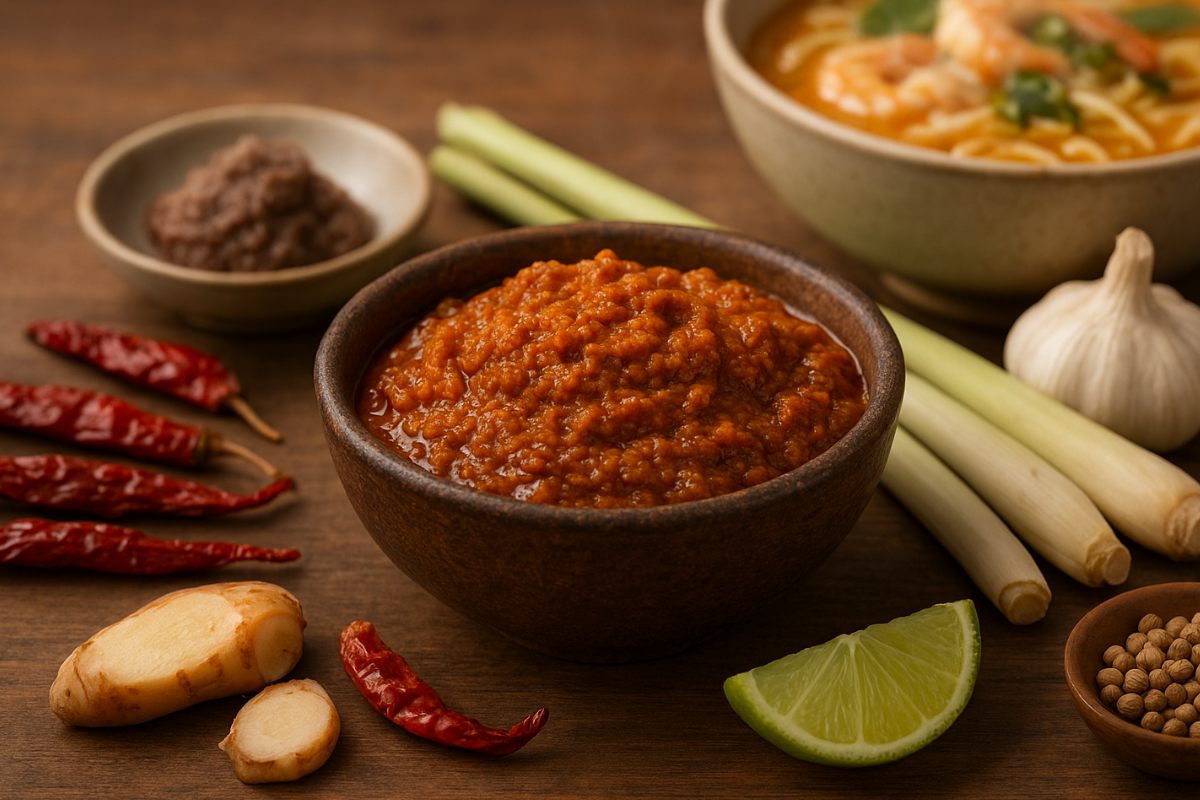A laksa paste recipe brings the rich flavors of Southeast Asia straight into your kitchen. It’s one of the must-try foods in Singapore, loved for its bold and comforting taste. For food lovers, social media users, and home cooks alike, this recipe is a way to make a flavorful base that turns any ordinary noodle dish into something truly comforting. While store-bought versions are easy to find, making your own paste allows you to adjust the heat, depth, and freshness in every spoonful. By preparing it yourself, you create a personalized flavor that keeps people coming back for more.
This article will guide you through the history and flavors of laksa, the ingredients you need, and the steps to create a paste from scratch. It will also share ideas on how to use, store, and adapt it for different diets or personal tastes.
The Allure of Laksa and Why Homemade Paste Matters
Laksa is one of Southeast Asia’s most iconic noodle dishes, known for its comforting balance of spicy, creamy, and savory flavors. At the center of every steaming bowl lies the paste, the element that defines its character. Without it, laksa loses its bold personality.
Making paste at home allows you to control every layer of flavor. If you love extra heat, you can add more chilies. If you prefer something milder, you can hold back. Store-bought jars may save time, but they rarely capture the same freshness or complexity. A homemade laksa paste recipe also gives you freedom to adapt, whether you want a traditional style or a creative twist.
What is Laksa Paste?
Laksa paste serves as the foundation of the dish. It combines aromatics, spices, and seafood flavors to create the soup’s rich base. It is often found in bustling food courts where culture and flavors come together, especially at some of the best hawker centres across the city. Two main styles exist: laksa lemak, which uses coconut milk for a creamy texture, and asam laksa, which relies on tamarind for a tangy finish. Both versions share a vibrant blend of chilies, herbs, and spices.
This paste balances spice with fragrance. Lemongrass, galangal, and kaffir lime add brightness, while shrimp paste deepens the savory notes. When fried in oil, the mixture transforms into an aromatic base that perfumes the entire kitchen. Understanding this balance is key to mastering the recipe.
Ingredients for a Laksa Paste Recipe
A successful laksa paste starts with a thoughtful mix of ingredients. Every component contributes to the final aroma and taste, and once combined, they create a harmony that is bold yet comforting.
For the Laksa Paste (Main Component):
- 6 dried red chilies, soaked in hot water until softened
- 4 fresh red chilies, deseeded
- 6 shallots, peeled
- 4 cloves garlic, peeled
- 2 stalks lemongrass, white part only, chopped
- 1-inch piece galangal, peeled and chopped
- 1-inch piece ginger, peeled and chopped
- 5 candlenuts or macadamia nuts
- 1 tsp turmeric powder
- 1 tsp shrimp paste (belacan), toasted
- 1 tsp coriander seeds, toasted
- ½ tsp white pepper
Optional Ingredients / Adjustments:
- 1–2 tbsp vegetable oil (for frying paste)
- 1 tsp sugar (to balance heat)
- Extra chilies for more spiciness
Tools and Preparation Tips
Having the right tools on hand makes preparing laksa paste easier and ensures the best results. Gather these essential items before you start to streamline the process and make cooking more enjoyable:
- Blender or food processor
- Cutting board and knife
- Frying pan or wok
- Wooden spoon or spatula
- Airtight jar for storage
Blender or mortar and pestle (pros and cons) are both common tools, and anyone keen to refine these skills can join Singapore cooking classes to learn from local chefs.
Step-by-Step Instructions
Making laksa paste from scratch may seem daunting, but following these steps will guide you through the process smoothly. With a few simple techniques, you can create a fragrant, flavorful paste that’s perfect for a variety of dishes.
- Prepare Ingredients: Soak dried chilies in hot water for 15 minutes until soft. Peel and chop shallots, garlic, ginger, and galangal. Trim and chop lemongrass.
- Toast Spices & Nuts: In a dry pan, toast coriander seeds and candlenuts until fragrant. Set aside to cool.
- Blend Paste: Combine all ingredients (soaked dried chilies, fresh chilies, shallots, garlic, lemongrass, galangal, ginger, toasted spices, candlenuts, turmeric, shrimp paste, and white pepper) in a blender or food processor. Blend into a smooth paste, adding a little oil if needed to help blend.
- Cook Paste: Heat 1–2 tbsp vegetable oil in a frying pan over medium heat. Fry the paste, stirring frequently, for 5–7 minutes until fragrant and slightly darker in color.
- Cool & Store: Remove from heat and let the paste cool completely. Transfer to an airtight jar. Store in the fridge for up to 2 weeks or freeze for longer storage.
Tips for Success & Variations
Making the perfect laksa paste requires some attention to detail, but a few simple strategies can help you elevate your flavors. Here are key tips and variations to ensure your paste turns out aromatic, balanced, and delicious.
Adjust Spice Levels
Laksa paste can be quite spicy, but you can easily tailor the heat to your taste. Reduce or remove seeds from chilies, or use fewer dried chilies if you prefer a milder paste.
Use Fresh Aromatics
The freshness of your ingredients directly impacts the aroma and flavor of the paste. Make sure your shallots, lemongrass, ginger, and galangal are fresh for the best results.
Fry the Paste for Deeper Flavor
Cooking the paste before using it brings out richer, more complex flavors. Lightly fry until fragrant and slightly darker in color for a truly aromatic paste.
Nut Substitutions
Candlenuts add creaminess and depth to laksa paste, but you don’t have to be limited to them. Macadamia nuts or cashews toasted lightly make excellent alternatives.
Experiment with Sweetness
A small amount of sugar can balance the heat and enhance the overall flavor profile. Start with 1 teaspoon and adjust according to your preference.
Laksa Paste Serving Suggestions & Storage
Laksa paste is incredibly versatile and can be used to create a variety of delicious dishes. Stir it into coconut milk to make a fragrant laksa soup with noodles, prawns, tofu puffs, and fresh herbs, or use it as a base for a quick curry with chicken, seafood, or vegetables. You can also mix a small amount into stir-fries to add a burst of flavor, or even blend it with coconut cream for a rich sauce to drizzle over grilled proteins.
To keep your laksa paste fresh, store it in an airtight jar in the refrigerator for up to two weeks. For longer storage, portion the paste into small containers or ice cube trays and freeze for up to three months. Defrost portions as needed before adding them to your dishes. This way, you always have flavorful laksa paste on hand for quick and easy meals.
Why This Laksa Paste Recipe Belongs in Your Collection
Making your own laksa paste gives you control, freshness, and creativity. You can adjust the spice to your liking, experiment with variations, and use it in ways beyond the traditional soup. A homemade paste captures the soul of Southeast Asian cooking and turns every meal into a flavorful experience.
If you want a dish that always impresses, this laksa paste recipe deserves a permanent place in your kitchen. Every spoonful carries the richness of tradition while letting you shape the flavors to match your style.
Frequently Asked Questions
If you’re new to making laksa paste from scratch, you might have a few questions about ingredients, storage, or substitutions. Here are some of the most common questions to help you get it right the first time.
Q: Can I make laksa paste without a food processor?
A: Yes, you can use a mortar and pestle for a more traditional approach, though it takes more time and effort. The flavors can actually be deeper because pounding releases the oils from the aromatics.
Q: What can I use instead of candlenuts?
A: Macadamia nuts or cashews are great substitutes if candlenuts aren’t available. They add the same creamy richness to the paste.
Q: How long does homemade laksa paste last?
A: Stored in an airtight container in the fridge, laksa paste will keep for up to 2 weeks. For longer storage, freeze it in small portions for up to 3 months.
Q: Can I adjust the spiciness of laksa paste?
A: Definitely! Simply reduce the number of dried chilies or remove the seeds to make it milder. For extra heat, add more chilies or even a small fresh chili to the blend.









